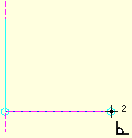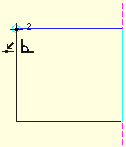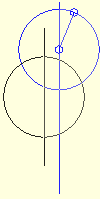A perpendicular relation can exist between two lines, chamfers or axes; or between a line, a chamfer or an axis and a circular object (an arc, a fillet or a circle). When a perpendicular relation is set between two objects, they remain perpendicular regardless of any changes you make in their position or size.
When two objects are perpendicular and one of them is circular, the center of the circular object lies on the axis, line or chamfer (or on their extensions), and the line, chamfer or axis is perpendicular to an imaginary line that is tangent to the circular object. When two lines are perpendicular, their point of perpendicularity may be either internal (lying on both lines) or external (lying on an extension of at least one of the lines).
To detect a perpendicular relation implicitly
When the perpendicular relation indicator appears, a perpendicular relation has been detected between the object you are drawing and another object.
note: Perpendicular relation can be detected implicitly if the Perpendicular check box in the Tools | Options | Relations tab is selected.
To detect a perpendicular relation explicitly
Example
In the first example, the end point of each line is drawn so that the current line is perpendicular to the previous one.





The next example shows a perpendicular relation between a line and a circle.


